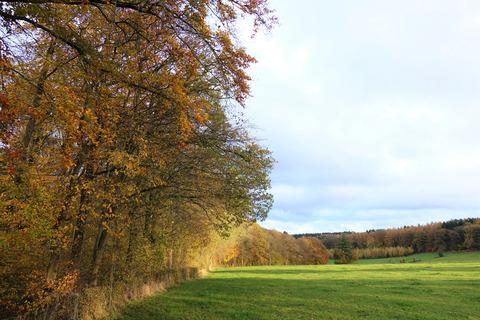当前位置:
X-MOL 学术
›
Journal of Vegetation Science
›
论文详情
Our official English website, www.x-mol.net, welcomes your
feedback! (Note: you will need to create a separate account there.)
Edge influence on understorey plant communities depends on forest management
Journal of Vegetation Science ( IF 2.2 ) Pub Date : 2020-02-05 , DOI: 10.1111/jvs.12844 Sanne Govaert 1 , Camille Meeussen 1 , Thomas Vanneste 1 , Kurt Bollmann 2 , Jörg Brunet 3 , Sara A. O. Cousins 4 , Martin Diekmann 5 , Bente J. Graae 6 , Per‐Ola Hedwall 3 , Thilo Heinken 7 , Giovanni Iacopetti 8 , Jonathan Lenoir 9 , Sigrid Lindmo 7 , Anna Orczewska 10 , Michael P. Perring 1, 11 , Quentin Ponette 12 , Jan Plue 4 , Federico Selvi 8 , Fabien Spicher 9 , Matteo Tolosano 1, 13 , Pieter Vermeir 14 , Florian Zellweger 2, 15 , Kris Verheyen 1 , Pieter Vangansbeke 1 , Pieter De Frenne 1
Journal of Vegetation Science ( IF 2.2 ) Pub Date : 2020-02-05 , DOI: 10.1111/jvs.12844 Sanne Govaert 1 , Camille Meeussen 1 , Thomas Vanneste 1 , Kurt Bollmann 2 , Jörg Brunet 3 , Sara A. O. Cousins 4 , Martin Diekmann 5 , Bente J. Graae 6 , Per‐Ola Hedwall 3 , Thilo Heinken 7 , Giovanni Iacopetti 8 , Jonathan Lenoir 9 , Sigrid Lindmo 7 , Anna Orczewska 10 , Michael P. Perring 1, 11 , Quentin Ponette 12 , Jan Plue 4 , Federico Selvi 8 , Fabien Spicher 9 , Matteo Tolosano 1, 13 , Pieter Vermeir 14 , Florian Zellweger 2, 15 , Kris Verheyen 1 , Pieter Vangansbeke 1 , Pieter De Frenne 1
Affiliation

|
Questions: Does the influence of forest edges on plant species richness and composition depend on forest management? Do forest specialists and generalists show contrasting patterns? Location: Mesic, deciduous forests across Europe. Methods: Vegetation surveys were performed in forests with three management types (unthinned, thinned 5–10 years ago and recently thinned) along a macroclimatic gradient from Italy to Norway. In each of 45 forests, we established five vegetation plots along a south‐facing edge‐to‐interior gradient (n = 225). Forest specialist, generalist and total species richness, as well as evenness and proportion of specialists, were tested as a function of the management type and distance to the edge while accounting for several environmental variables (e.g. landscape composition and soil characteristics). Magnitude and distance of edge influence were estimated for species richness per management type. Results: Greatest total species richness was found in thinned forests. Edge influence on generalist plant species richness was contingent on the management type, with the smallest decrease in species richness from the edge‐to‐interior in unthinned forests. In addition, generalist richness increased with the proportion of forests in the surrounding landscape and decreased in forests dominated by tree species that cast more shade. Forest specialist species richness, however, was not affected by management type or distance to the edge, and only increased with pH and increasing proportion of forests in the landscape. Conclusions: Forest thinning affects the plant community composition along edge‐to‐interior transects of European forests, with richness of forest specialists and generalists responding differently. Therefore, future studies should take the forest management into account when interpreting edge‐to‐interior because both modify the microclimate, soil processes and deposition of polluting aerosols. This interaction is key to predict the effects of global change on forest plants in landscapes characterized by the mosaic of forest patches and agricultural land that is typical for Europe.
中文翻译:

对林下植物群落的边缘影响取决于森林管理
问题:森林边缘对植物物种丰富度和组成的影响是否取决于森林管理?森林专家和通才是否表现出截然不同的模式?位置:欧洲各地的落叶林。方法:沿着从意大利到挪威的大气候梯度,在具有三种管理类型(未间伐、5-10 年前间伐和最近间伐)的森林中进行植被调查。在 45 个森林中的每一个中,我们沿着朝南的边缘到内部的梯度(n = 225)建立了五个植被地块。森林专家、通才和总物种丰富度,以及专家的均匀度和比例,作为管理类型和到边缘的距离的函数进行测试,同时考虑了几个环境变量(例如景观组成和土壤特征)。根据每种管理类型的物种丰富度估计边缘影响的大小和距离。结果:在稀疏的森林中发现了最大的总物种丰富度。边缘对一般植物物种丰富度的影响取决于管理类型,在未减薄的森林中,物种丰富度从边缘到内部的减少最小。此外,多面性丰富度随着周围景观中森林比例的增加而增加,而在以树种为主的森林中,遮荫度较高的森林则减少。然而,森林专业物种丰富度不受管理类型或到边缘距离的影响,只会随着 pH 值和景观中森林比例的增加而增加。结论:森林间伐影响沿欧洲森林边缘到内部横断面的植物群落组成,随着森林专家和通才的丰富反应不同。因此,未来的研究在解释边缘到内部时应考虑森林管理,因为两者都会改变小气候、土壤过程和污染气溶胶的沉积。这种相互作用是预测全球变化对欧洲典型的森林斑块和农业用地镶嵌景观中森林植物影响的关键。
更新日期:2020-02-05
中文翻译:

对林下植物群落的边缘影响取决于森林管理
问题:森林边缘对植物物种丰富度和组成的影响是否取决于森林管理?森林专家和通才是否表现出截然不同的模式?位置:欧洲各地的落叶林。方法:沿着从意大利到挪威的大气候梯度,在具有三种管理类型(未间伐、5-10 年前间伐和最近间伐)的森林中进行植被调查。在 45 个森林中的每一个中,我们沿着朝南的边缘到内部的梯度(n = 225)建立了五个植被地块。森林专家、通才和总物种丰富度,以及专家的均匀度和比例,作为管理类型和到边缘的距离的函数进行测试,同时考虑了几个环境变量(例如景观组成和土壤特征)。根据每种管理类型的物种丰富度估计边缘影响的大小和距离。结果:在稀疏的森林中发现了最大的总物种丰富度。边缘对一般植物物种丰富度的影响取决于管理类型,在未减薄的森林中,物种丰富度从边缘到内部的减少最小。此外,多面性丰富度随着周围景观中森林比例的增加而增加,而在以树种为主的森林中,遮荫度较高的森林则减少。然而,森林专业物种丰富度不受管理类型或到边缘距离的影响,只会随着 pH 值和景观中森林比例的增加而增加。结论:森林间伐影响沿欧洲森林边缘到内部横断面的植物群落组成,随着森林专家和通才的丰富反应不同。因此,未来的研究在解释边缘到内部时应考虑森林管理,因为两者都会改变小气候、土壤过程和污染气溶胶的沉积。这种相互作用是预测全球变化对欧洲典型的森林斑块和农业用地镶嵌景观中森林植物影响的关键。










































 京公网安备 11010802027423号
京公网安备 11010802027423号